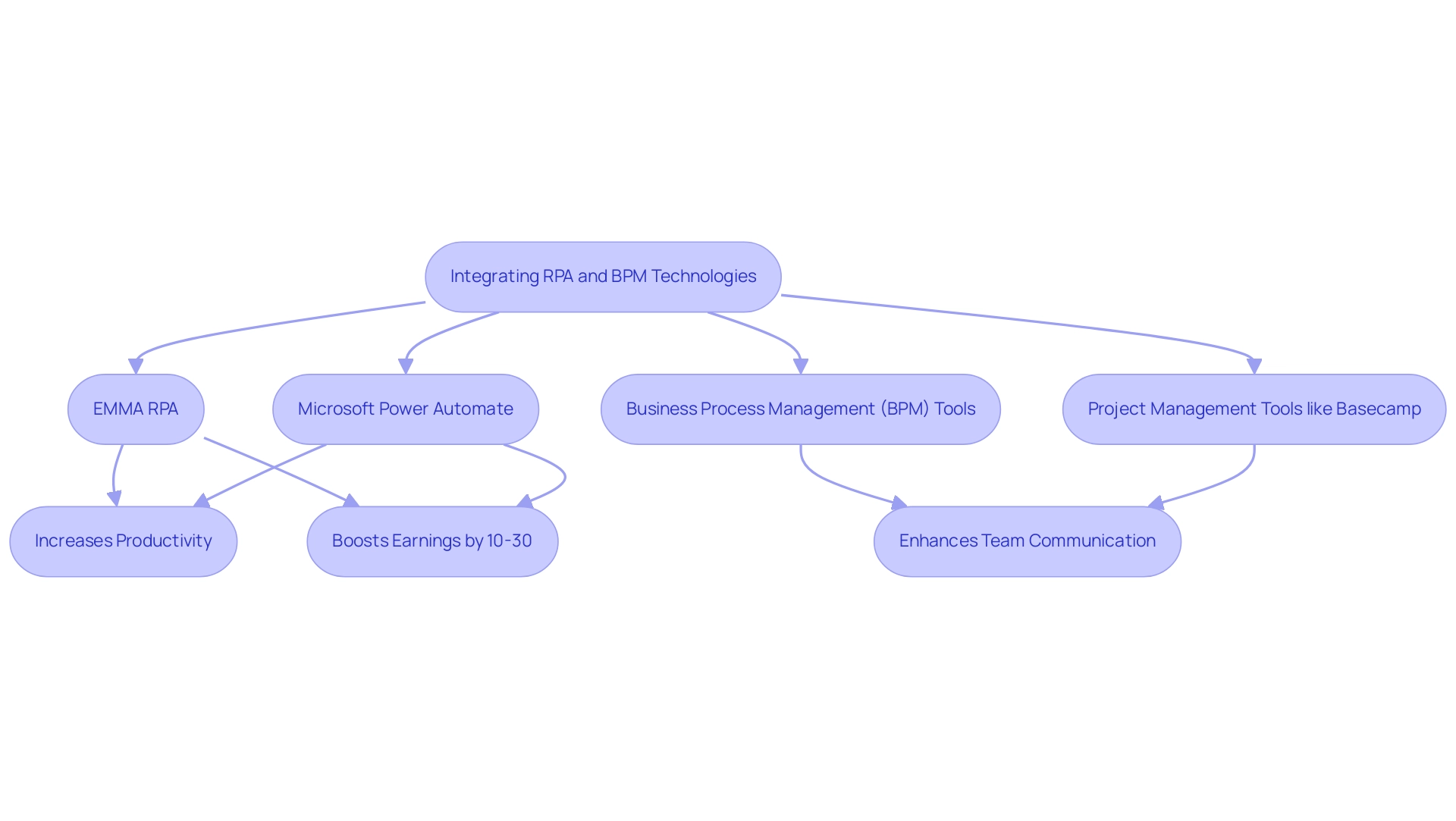Introduction
In an age where efficiency is paramount, mastering the task capture process has emerged as a crucial step for organizations striving to embrace automation successfully. By meticulously documenting and analyzing business processes, companies can uncover inefficiencies that hinder productivity and identify opportunities for innovative solutions like Robotic Process Automation (RPA).
With a growing number of businesses recognizing the transformative potential of automation—evidenced by significant reductions in errors and accelerated workflows—it’s clear that the journey toward operational excellence begins with a comprehensive understanding of task capture.
This article delves into effective strategies and best practices that empower organizations to optimize their automation efforts, ensuring they not only enhance efficiency but also position themselves for future growth in an increasingly competitive landscape.
Understanding the Task Capture Process for Effective Automation
The process of task capture download is an essential element in the journey toward effective mechanization, encompassing the documentation and analysis of each step in a business process. This meticulous approach not only allows organizations to pinpoint bottlenecks and repetitive activities but also recognizes inefficiencies that can be effectively tackled through innovative solutions like graphical user interface enhancements. A recent case study involving a mid-sized healthcare company illustrates this; they faced significant challenges such as manual data entry errors and slow software testing, but experienced a remarkable 70% reduction in data entry errors and a 50% acceleration in software testing by adopting graphical user interface techniques.
Research indicates that employees in the IT industry can save between 10% to 50% of their time by automating these repetitive activities, underscoring the potential for significant productivity gains. For example, companies may discover that their invoice handling requires many manual steps, which could be improved using robotic techniques like EMMA RPA and Microsoft Power Automate. By carefully outlining these activities, organizations can ensure their strategies are not only focused but also effective, ultimately leading to increased operational efficiency.
Moreover, the implementation of mechanization is gaining traction; currently, nearly 37% of businesses report lacking the technology necessary to streamline and organize their onboarding processes. This gap offers a notable chance for leaders to improve their operations through efficient task capture download and mechanization. As emphasized by Tidio, almost 70% of recruiters acknowledge AI as an essential resource for removing unconscious bias in hiring, illustrating the wider consequences of adopting technology across different functions.
Notably, 25% of companies have already embraced HR technology for essential tasks like screening resumes and scheduling interviews, allowing HR professionals to redirect their focus towards employee development. Moreover, staying updated on the latest trends in robotic task management is essential, as these advancements persist in evolving and influencing how companies function. This trend demonstrates the transformative influence of task capture download by recording business processes prior to starting initiatives, paving the way for organizations to enhance efficiency and achieve success.
Importantly, the ROI from the GUI automation implementation was achieved within six months, highlighting the effectiveness of this strategy.

Best Practices for Optimizing Task Capture
To improve the efficiency of activity recording for task capture download, organizations should embrace several essential best practices, particularly in the context of addressing repetitive activities and obsolete systems through innovative RPA solutions. Involving stakeholders from different departments is essential, as it guarantees a diverse array of viewpoints that enhance the comprehension of activities being recorded. Recent developments reveal that 73% of enterprises have embraced a hybrid cloud approach, suggesting a transition towards collaborative settings that can greatly enhance initiative capture endeavors.
Secondly, utilizing sophisticated discovery tools, such as EMMA RPA and Microsoft Power Automate, is crucial. These tools can automatically record user interactions across applications, offering a precise representation of workflows. For instance, Ula’s implementation of such tools resulted in a remarkable 70% reduction in mundane HR activities and a decrease in Slack queries from 100% to just 1.25% between review cycles, demonstrating the power of automated insights in enhancing efficiency and employee morale.
Moreover, it is vital that the data captured is both clear and detailed. This includes documenting decision points and any potential exceptions that may arise throughout the process. As the worldwide healthcare mechanization sector is expected to increase at an impressive rate of 8.415% over the next seven years, organizations that prioritize high-quality activity recording can position themselves for success in this expanding market.
Moreover, considering that 31% of enterprises have completely streamlined at least one essential function, the task capture download becomes progressively vital in propelling efficiency initiatives. Addressing staffing shortages, RPA solutions can help streamline operations, making it easier to attract and retain talent by reducing the burden of repetitive activities. Furthermore, the emotional impact of these responsibilities on employee morale can be reduced through mechanization, enabling staff to concentrate on more engaging work.
With the North American document management software market valued at $2.79 billion, improving workflow collection methods can significantly enhance document management strategies within organizations. By adhering to these optimal methods, organizations can improve their work documentation systems, thus boosting overall operational effectiveness and facilitating future advancements in mechanization.

The Importance of Document Download Tracking in Task Capture
Document download tracking plays a crucial role in organizations aiming to enhance their task capture download processes, particularly in the context of improving operational efficiency in healthcare. By meticulously monitoring which documents are downloaded and by whom, companies can glean valuable insights into user behavior and identify frequently accessed resources. For example, if a particular document is frequently downloaded before performing the work, it may indicate a shared dependency that requires mechanization or simplification.
This understanding is particularly timely, as:
- 27% of businesses cite spiraling costs as a significant barrier to implementing paperless office tools
- 41% of small businesses face skills shortages that complicate the adoption of effective document tracking systems
The ongoing evolution of these systems presents both opportunities and challenges, particularly concerning data privacy and cybersecurity risks. As document tracking becomes more interconnected and reliant on cloud infrastructure, organizations must address these challenges to ensure secure operations.
Leveraging RPA solutions like EMMA RPA and Microsoft Power Automate can transform business operations by automating repetitive tasks, ultimately enhancing efficiency and employee morale. Flexera’s discoveries show that:
- 73% of companies adopted a hybrid cloud strategy in 2023, highlighting the need for strong monitoring systems that improve visibility into operations and guide strategic choices related to efficiency opportunities
In the case study of a mid-sized company, implementing GUI mechanization led to:
- A 70% reduction in data entry mistakes
- A 50% speedup in testing activities
- An 80% enhancement in workflow efficiency, with ROI realized within six months
Initially, the company faced significant challenges, including manual data entry errors and slow software testing, which highlighted the critical need for automation. As organizations navigate these complexities, effective task capture download tracking becomes indispensable for optimizing business processes and enhancing operational efficiency.
![]()
Leveraging Tools and Technologies for Enhanced Task Capture
Organizations today can significantly enhance workflow capture and overall efficiency by leveraging innovative Robotic Process Automation (RPA) tools like EMMA RPA and Microsoft Power Automate. EMMA RPA is designed for operational efficiency, enabling seamless automatic activity recording and addressing common challenges such as repetition fatigue and outdated systems. Microsoft Power Automate transforms operations by streamlining workflows, allowing employees to focus on higher-value activities, ultimately boosting morale and productivity.
Statistics indicate that mechanization can help companies achieve a remarkable 10-30% increase in earnings, illustrating the financial advantages of adopting these technologies. Additionally, Business Process Management (BPM) tools complement RPA by mapping workflows and identifying areas for improvement. For instance, Basecamp serves as an effective project management tool that enhances team communication and integrates with various applications to optimize productivity.
By integrating RPA and BPM technologies, organizations can enhance their methods for task capture download and pave the way for comprehensive automation. As Samuli Sipilä, an RPA Business Analyst at Elisa, remarks, ‘The task capture download feature has provided us with a unified way of easily creating flowcharts to represent the high-level process flow. As a business analyst, I receive ready-to-go instructions which I then incorporate into the PDD.’
This methodology not only enhances efficiency but also empowers teams to dedicate their efforts to strategic initiatives, fostering a culture of innovation and growth. Notable ETL tools such as Airbyte and Talend further illustrate the practical uses of mechanization in activity collection, offering real-world perspectives on operational enhancement. Book a free consultation to explore how our RPA solutions can benefit your organization.

Overcoming Challenges in Task Capture Implementation
Executing project documentation poses multiple difficulties, particularly worker opposition to embracing new procedures. To tackle this, organizations must emphasize efficient communication and education regarding the advantages of project recording and mechanization. As emphasized by a recent report, 83% of employees using AI-driven tools believe it significantly reduces burnout and enhances job satisfaction, showcasing a clear advantage to embracing these technologies.
Arranging extensive training sessions, like those provided in our GenAI workshops, can further facilitate employees’ transition to new systems, enabling them to utilize activity recording effectively while ensuring ethical AI practices are followed throughout the process.
Another common challenge is maintaining data accuracy during the recording process. Organizations can mitigate this risk by conducting regular audits and actively involving team members in the verification of captured data. This collaborative approach not only boosts accuracy but also fosters a sense of ownership among employees, enhancing their engagement in the process of mechanization.
In the context of the growing trend towards mechanization, with 31% of businesses already fully implementing key functions, the market for mechanization is expanding at a remarkable rate of 20% per year. This highlights the urgency for organizations to adopt effective strategies for implementation of duties. Our case study on enhancing operational efficiency through GUI streamlining in a mid-sized company exemplifies this trend, demonstrating measurable outcomes such as a 70% reduction in data entry errors and an 80% improvement in workflow efficiency.
By proactively tackling these challenges and embracing tools like Grafana and Prometheus for observability, organizations can cultivate a culture of innovation and efficiency, positioning themselves for successful task capture download and a risk-free, ROI-driven journey. Furthermore, the integration of personalized customer experiences through our GenAI services ensures that automation not only enhances operational efficiency but also enriches customer interactions.

Conclusion
Mastering the task capture process is essential for organizations aiming to harness the full potential of automation. By meticulously documenting and analyzing business processes, companies can identify inefficiencies and repetitive tasks that hinder productivity. The case studies and statistics highlighted in this article demonstrate that adopting innovative solutions such as Robotic Process Automation (RPA) can lead to significant improvements, including reduced errors and accelerated workflows.
Best practices in task capture, such as engaging diverse stakeholders and utilizing advanced process discovery tools, not only enhance the accuracy of data capture but also foster a culture of collaboration and innovation. As organizations increasingly adopt automation, understanding the intricacies of their processes becomes vital for optimizing operational efficiency and positioning themselves for future growth.
Moreover, the importance of effective document tracking and leveraging the right tools cannot be overstated. These strategies not only streamline operations but also provide invaluable insights that drive informed decision-making. As the automation landscape continues to evolve, embracing these practices will empower organizations to overcome challenges and thrive in a competitive environment. In this journey toward operational excellence, organizations that prioritize task capture will find themselves well-equipped to navigate the complexities of automation, ultimately achieving a remarkable return on investment and enhanced employee satisfaction.

